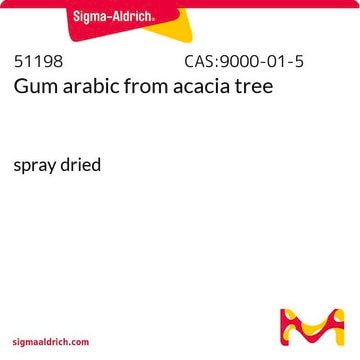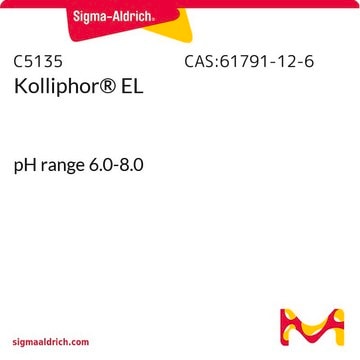12-1820
Gum arabic from acacia tree
CP
Synonym(s):
Acacia gum
Sign Into View Organizational & Contract Pricing
All Photos(1)
About This Item
grade:
CP
Recommended Products
grade
CP
availability
available only in Japan
dilution
(for analytical testing)
Looking for similar products? Visit Product Comparison Guide
Other Notes
Believed to be a branched polymer of galactose, rhamnose, arabinose, and glucuronic acid as the calcium, magnesium, and potassium salts with a mol. wt. of approx. 250,000.
Storage Class Code
11 - Combustible Solids
WGK
WGK 3
Flash Point(F)
Not applicable
Flash Point(C)
Not applicable
Personal Protective Equipment
dust mask type N95 (US), Eyeshields, Gloves
Choose from one of the most recent versions:
Already Own This Product?
Find documentation for the products that you have recently purchased in the Document Library.
Omaima Nasir et al.
Kidney & blood pressure research, 35(5), 365-372 (2012-04-05)
Gum arabic (GA) is a Ca(2+)-, Mg(2+)- and K(+)-rich dietary fiber used for the treatment of patients with chronic kidney disease in Middle Eastern countries. In healthy mice, GA treatment increases creatinine clearance, renal ADH excretion, as well as intestinal
Badreldin H Ali et al.
PloS one, 8(2), e55242-e55242 (2013-02-06)
Inflammation and oxidative stress are known to be involved in the pathogenesis of chronic kidney disease in humans, and in chronic renal failure (CRF) in rats. The aim of this work was to study the role of inflammation and oxidative
Yadong Yang et al.
Food chemistry, 135(2), 555-561 (2012-08-08)
The interactions between fish gelatin (FG) and gum arabic (GA) in aqueous solutions were investigated by turbidimetry, methylene blue spectrophotometry, zeta potentiometry, dynamic light scattering, protein assay, and state diagram at 40 °C and a total biopolymer concentration (C(T)) of
Igor A Schepetkin et al.
International immunopharmacology, 8(10), 1455-1466 (2008-07-04)
Opuntia polyacantha (prickly pear cactus) has been used extensively for its nutritional properties; however, less is known regarding medicinal properties of Opuntia tissues. In the present study, we extracted polysaccharides from O. polyacantha and used size-exclusion chromatography to fractionate the
Jason M Unrine et al.
Environmental science & technology, 46(13), 6915-6924 (2012-03-29)
To better understand their fate and toxicity in aquatic environments, we compared the aggregation and dissolution behavior of gum arabic (GA) and polyvinylpyrrolidone (PVP) coated Ag nanoparticles (NPs) in aquatic microcosms. There were four microcosm types: surface water; water and
Our team of scientists has experience in all areas of research including Life Science, Material Science, Chemical Synthesis, Chromatography, Analytical and many others.
Contact Technical Service






